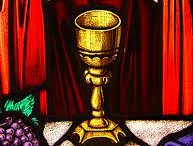14 July 2022
Holy Blood and the…
Arthur Brand, Henry Lincoln, Dan Brown.
By Neil Tidmarsh

Last week this column – with its mention of the Holy Grail and the Fisher King and the Knights of the Round Table – threatened to stray into the kind of intellectually and artistically questionable territory best left to Dan Brown. This week, however, thanks to the current brain-churning heat-wave and a crime report by Bruno Waterfield in today’s The Times, it’s going to crash right through the “Stop! Danger!” signs and give Robert Langdon a run for his money…
For three days and nights last week, following the arrival of a mysterious email, renowned art detective Arthur Brand hardly dared to sleep. He waited, and waited. That email – was it a hoax? Had its sender changed his mind? And then, at 10.30pm on Friday, soon after darkness had fallen, the doorbell rang. He looked down from the balcony of his house in Amsterdam and there, just visible in the shadows by his front door, was a box. The street was empty – whoever had abandoned the mysterious package had already disappeared back into the night.
He rushed downstairs (“my heart was beating fast in my chest”) and grabbed the delivery and took it inside before anyone else could snatch it. The anonymous email hadn’t been a hoax. The package contained a stash of treasure which had been stolen from the Abbey of the Holy Trinity at Fécamp in Normandy six weeks ago. Arthur Brand found goblets and dishes – and a bejewelled and gilded copper reliquary 11 inches high. Inside this ornate casket was the abbey’s priceless and most sacred treasure; two lead phials reputedly filled with “the precious blood of Christ”.
The thieves had apparently panicked as soon as they realised exactly what it was that they’d stolen. Not only did it dawn on them that “you in fact cannot sell it”, Brand said, but they also believed that they would be cursed; “To have the ultimate relic, the blood of Christ, which you have stolen, in your home is a curse, even if you are not a believer.” An accomplice of the thief contacted Brand, a Dutch detective famous for finding or recovering stolen or missing works of art, and arranged for the stolen goods’ return. Brand has passed them to the Dutch police. They’ll be handed back to the Abbey after they’ve been verified as genuine and not forgeries palmed off on them by the thieves as a smokescreen to hide their tracks.
The Abbey believes that Joseph of Arimathea collected the blood after the Crucifixion, in the chalice – the Holy Grail – which Christ had used in the Last Supper. He then fled to distant Britain, beyond the frontiers of the known world, to escape Roman persecution. But his ship was intercepted by a Roman vessel while crossing the Channel, and he cast the casket containing the blood overboard rather than have it seized by Roman soldiers. It floated ashore and has been in the possession of the Abbey ever since, attracting pilgrims for over a thousand years. The theft took place only a fortnight before the Abbey was due to commemorate this relic with a special traditional Mass which has been celebrated every year for more than a millennium.
Joseph of Arimathea, “a rich man and a good councillor”, is mentioned in all four gospels as the disciple who recovered Christ’s body from Pontius Pilate and interred it in the tomb which he’d had built for himself. Many legends grew up around him, most of them associated with Britain, oddly enough. There’s a Cornish legend which claims that he was a merchant and came to Cornwall for tin (there was indeed an established trade between the Cornish mines and the Mediterranean world in ancient times), and that he was Christ’s uncle, and that when Christ was a young boy he accompanied Joseph on one of those trading voyages to Cornwall (William Blake’s “And did those feet in ancient times / Walk upon England’s mountains green…” refers to this legend).
Legend also claims that Joseph founded Glastonbury Abbey when he came ashore in Britain after fleeing Roman persecution. A thorn tree which has apparently flourished at Glastonbury for thousands of years is supposed to have grown from the staff that he thrust into the ground on his arrival. (As the originator of Glastonbury’s spiritual aura – not so ‘New’ Age after all – he could also claim to be the founding father of the Glastonbury Festival, celebrated so enthusiastically last month for the first time since the pandemic began). And legend says that he came ashore with the Holy Grail, even though he’d had to jettison the casket in which he’d stored the Holy Blood.
So what happened to the Holy Grail? Where is it now?
It’s still in Britain. It’s still at Glastonbury, hidden underground, the source of the Chalice Well which runs with blood-red water to this day. No, it’s in Aberystwyth, and otherwise known as the Nanteos Cup, held in the National Library of Wales. No, it’s in Lincoln Cathedral, found in the tomb of Bishop Oliver Sutton…
No, it’s in Spain, in the Basilica of San Isidoro in Leon… no, in the Chapel of the Holy Chalice in Valencia Cathedral… no, in the Montserrat Abbey, north of Barcelona… No, it’s in Italy, in Genoa Cathedral… no, in a secret room in the Vatican…
Ah, no, hang on, we all know now that the Holy Grail isn’t an actual cup or chalice, don’t we? Didn’t Henry Lincoln’s The Holy Blood and the Holy Grail reveal that it is in fact the womb (or wombs) of all the women who have carried Christ’s blood-line down the centuries from his time to ours? (Yes, Christ fathered a child with Mary Magdalene, and his descendants are still with us, their existence and whereabouts guarded by a secret society bound by sacred vows!!!). And in Dan Brown’s The Da Vinci Code, Robert Langdon discovers that his companion Sophie Neveu is the living descendent, the current Holy Grail…
Meanwhile, in a laboratory in Amsterdam, the beautiful but brilliant young Dutch scientist Dr Màxima Onzin, one of the team tasked by the Dutch police to verify that the returned treasures are genuine, suddenly realises that this is the solution to the impossible problem they’ve been wrestling with for the last week. “Of course! That’s how we can prove that this is the precious blood of Christ and not a forgery fobbed off on us by the thieves as a smokescreen to hide their tracks!”
“How?” grunts Professor Blankeman van Middlebare-Leeftijd. He is the team leader. He has piercing blue eyes and a long white beard.
“We find Sophie Neveu, Christ’s living descendant, and take a sample of her DNA and if it matches the DNA of the blood in these two vials, then we know the blood is genuine! We must contact Robert Langdon, he’ll know where we can find Miss Neveu!”
The professor snorts sceptically. “What? Are you crazy? Robert Langdon and Sophie Neveu don’t really exist! They’re fictional characters, for heaven’s sake!”
“But… but…” Dr Onzin knows she must summon up the courage to challenge her boss’s obstructionism. She knows that he is jealous of her brilliance. She knows that he is dull and pedestrian and has been grossly over-promoted just because he has blue eyes and a long white beard. “But Dan Brown…”
“Don’t be ridiculous! Dan Brown is a novelist! (And not a very good one either, even if he is a master of mystery and suspense and twisty surprises.) His ridiculously far-fetched stories are mere make-believe!”
“But… But… Henry Lincoln…”
“He simply made things up as well! It’s all nonsense!”
“But… couldn’t we ask him..?”
“No! Henry Lincoln died earlier this year! Didn’t you read his obituary in the papers last month?”
“I don’t believe you!” Dr Onzin glares at the professor. “So Henry Lincoln’s dead, is he? And Dan Brown’s far-fetched? And Robert Langdon and Sophie Neveu don’t exist? No, I don’t believe any of it! It’s all too convenient! You’re hiding something, aren’t you? This is a conspiracy, a cover-up! Well, I’m going to find out the truth, and no one’s going to stop me!” She storms out of the laboratory.
The professor stares after her, biting his lip. Then he reaches for his mobile and dials a number. His eyes narrow threateningly. “She’s onto us” he says in a hushed tone. “We must stop her. Listen carefully. This is what you have to do…”


